|
|
Post by Jura on Oct 21, 2020 5:45:50 GMT -8
In heat engineering (and chem reactor) we love dealing with turbulence as the process efficiency dependents more strongly on the kind of flow than the temp difference. That's why I always put bricks in lower parts of stove's bell in a way to create protrusions. I started to play with CFD software (openfoam, simflow) to model the gas behavior in bell stoves but gave up do to too many variables I could not set in the soft. (and lack of time) Vortex Can You recall our talk about Russian book of eng. Kolevyatov? |
|
|
|
Post by Vortex on Oct 21, 2020 10:33:00 GMT -8
Jura Yes, kolevatov liked his protuberances as well  @trevor, So the CO level in your heater core goes haywire when O² drops below 8%. I was expecting exactly that when the O² dipped down to 5.8% and 5.5% within ten minutes. But it didn't much to my surprise, now I have to find out whether or not this behaviour is repeatable. During both those low points the vortexes were looking quite violent. Two maelstroms moving in the direction of the glass in short bursts, seemingly out of sync with each other. I had something similar happen to me today, there might be a clue in it for you. I set the afterburner back to the original layout; no nose in the port, or sloped rear, or deeper afterburner. Exit port back to 105% port size. Also managed to make the top chamber exit to slightly over 1 CSA. Strong breeze outside. Stove took off faster than I expected and overfueled a bit for the first 10 minutes. It couldn't seem to catch it's breath even with the door open about an inch. It looked like the draw was too strong so at 21 minutes I got the idea to try closing the chimney damper half way. To my surprise it ran very happily between 6% to 8% O2 for the next quarter of an hour. www.vftshop.com/images/others/Stove/testo/testo-21-10-20.JPG
|
|
|
|
Post by peterberg on Oct 23, 2020 7:14:58 GMT -8
It looked like the air provision could be arranged entirely by having the door open 12 mm or 1/2". So the next run on the next day (20th) I plugged the whole of the air frame with rockwool and ran the thing with the door open at a fixed setting. This time a strong wind with sudden gusts and sometimes blowing back was a negative factor: it struggled the entire burn and even overfueled for 3 minutes in a spectacular way. 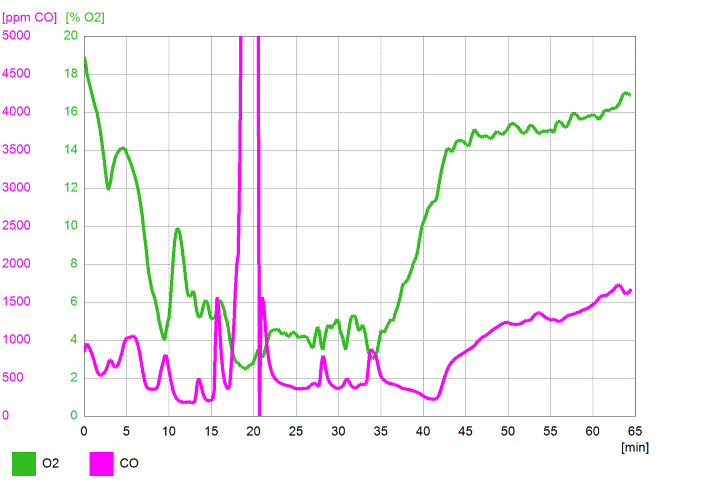 As one can imagine the lowest O² level was down south, 2.5%! Even though, during the 13 minutes part where it danced up and down between 3% and 5% O² it eyed quite stable. The temperature sensor was again mataglap (or berzerk?) so I left out the Tr and eff. lines for a clearer picture. @trevor: I think the clue you meant was that the exit of the core might work better not being 100%? I am thinking about how to shrink it a bit without opening the thing up. There's one thing I observed the last couple of times very clearly: the double vortex during startup is at the front of the port, more or less. But when it's running healthy, the fire stream seems to confine itself to the rear half of the port. This could be due to the Coanda effect, gases that are blown over a surface tend to cling to the surface. Just my interpretation. I won't be running any test until Monday when it's getting cooler, it's getting too hot in the house when I run this makeshift heater. This being a passive house and my workshop an integral part of it. My own heater in the living room isn't fired for 3 days now. Apart from that, the Testo has to be sent to the calibration facility. |
|
|
|
Post by Vortex on Oct 23, 2020 11:12:53 GMT -8
Shame the testo was playing up, that 13 minute section must have had an amazing efficiency reading. I wasn't referring to any particular clue, just thought there might be something in the list of changes I'd made that could help you figure out what the process is we're now both seeing. It didn't used to happen in my core, so that must be a result of the changes I recently made. I've increased the core exit size and see this effect when I create a restriction at the exit of the mass by partly closing the chimney damper. I can see that once the firebox is hot enough, adding a restriction after the mass causes slower transit of the hot gases through it, which results in increased heat extraction. A slower gas flow through the firebox requires a larger air supply to compensate, so that explains that, but why does it lower excess O2 in the chimney and why does the CO not rise as normal below 8% O2? That I don't understand. It's normal for the flame to use the front of the port at startup and move to the rear of the port as the afterburner gets hotter. I'd wondered why, but didn't know the Coanda effect could be influenced by temperature differences. I'm having to live with the door open all the time to be able to run a test once a day  |
|
|
|
Post by peterberg on Oct 23, 2020 12:40:28 GMT -8
The combustion process and related fluid dynamics together is complicated stuff. It might be that one change doesn't make any impact while a small one further downstream is doing the trick. Change another small thing and your desired results suddenly aren't there anymore. Added to the fact that every run is an unique event, different from all the rest. The trick is to have the differences as small as possible.
I didn't mean the Coanda effect could be influenced by temperature. I can imagine it is by speed, so why not?
I am living in a city (outside edge since 6 years), can't have the door open all the time unless I am sitting next to it.
|
|
|
|
Post by peterberg on Oct 24, 2020 11:39:28 GMT -8
Another test run today, late afternoon. I measured the port very carefully and found out it wasn't really symmetrical. By using high-temperature caulk as putty I managed to get it straight and both sides the same. The leading edge side is now 3 mm wider as compared to the trailing edge, distributed evenly between left and right. The front side is much more angled, I kept it this way. Keeping the post of Trevor in mind plus the fact that at the start of this experiment it behaved much more timid I restricted the core exit to 80% of system size. And hoping it would refrain from acting like a drag racer and behaving itself. In short: it didn't, see the diagram below. 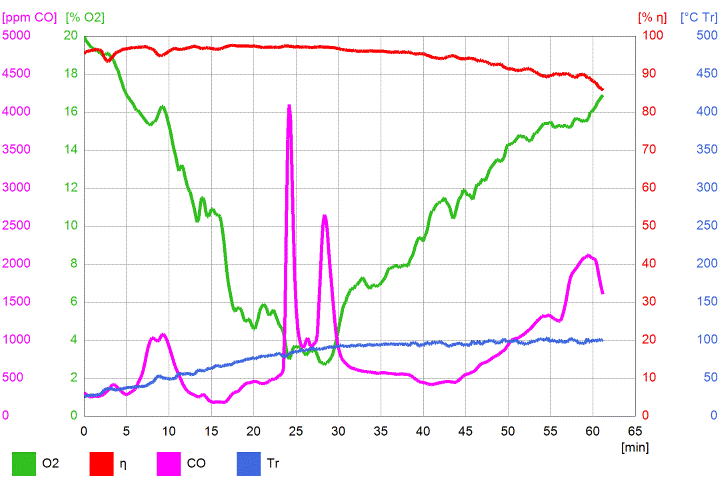 The oxygen level took a steep dive, down to the ridicously low point of 2.7%. I wasn't surprised to see the CO line rising sharply albeit it happened rather late, down to 4% O² and lower. Two steep spikes within 7 minutes and that was it. The raging double fire maelstrom was quite a violently sight to be seen, that's for sure. it started around 10 minutes into the burn and ended at around 54 minutes. Despite this not-so-beautiful diagram the numbers aren't bad at all, certainly much better than the coming EU norm. Averages: 11.0% O², 94.8% eff. 813 ppm CO, 79.4 ºC. Mean CO concentration at 13% O² would be 688 ppm, which is less than half as required for approval in 2022. I'm inclined to think this would be even better when the core could be tuned back a bit. I think restricting the core exit further is in order now, the block above the shelf isn't enough anymore. OR install a higher block, don't know yet. |
|
|
|
Post by peterberg on Oct 25, 2020 8:15:13 GMT -8
Another run, this time I narrowed the core's exit to 66% of system size, still as wide as the box. The amendment I did yesterday is probably not done the right way, the opening should have the thickness of the ceiling's material all around. In my case it was only at the front and the rear, not at the sides. Today I opened up the barrel and did it properly. The burn started a bit slower as compared to yesterday but still quick enough for me. The thing behaved itself admirably, didn't take a nose dive this time. Averages of this burn: 13.0% O², 94.4% eff., 687 ppm CO, 68.7 ºC. Not that much different from yesterday, but easier on the nerves. 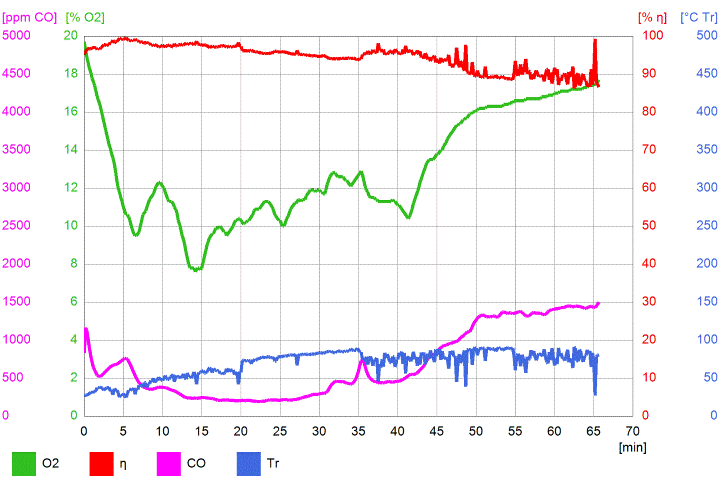 The box was loaded with 2.5 kg dry willow, tightly packed and dead against the rear wall. Yesterday I kept a small distance to allow the ends of the fuel to catch fire more easily. Next step: playing around a bit with the height of the stumbling block. Most of the approval tests seems to be done with very dry beech, because this'll give off lots of volatiles right after being lit. I am afraid the Testo calibration has to wait for another week. |
|
|
|
Post by Vortex on Oct 26, 2020 12:03:28 GMT -8
What size is the remaining area above/below the piece of pipe you are using as the stumbler in the top box? Also does the flame go beyond the stumbler?
In my core I found that if flame gets beyond the triangular piece on top of the afterburner shelf (similar to your stumbler in the top box) that the CO would immediately start going up. That's the main reason why I changed to calling that the exit port and the original one as the top chamber exit.
Since enlarging my top chamber exit to just over 1 csa, I've noticed that the core is less inclined to form a good strong double vortex, especially in the earlier part of the burn. The average CO ppm runs a bit higher (possibly due to being less inclined to form a good vortex), but excess O2 and stack temp are a bit lower. So maybe it's a trade off.
|
|
|
|
Post by peterberg on Oct 27, 2020 3:33:54 GMT -8
What size is the remaining area above/below the piece of pipe you are using as the stumbler in the top box? Below the stumbler, 106% of the port's csa. Also does the flame go beyond the stumbler? Sometimes is does for just a couple of seconds at the time. Since it is a rectangular steel duct it will get red hot when a lot of flames are passing through. In my core I found that if flame gets beyond the triangular piece on top of the afterburner shelf (similar to your stumbler in the top box) that the CO would immediately start going up. As mentioned, in my current experimental core it doesn't do that as such. The flames need to pass the stumbler for several minutes on end in order to push the CO level up steeply. Since enlarging my top chamber exit to just over 1 csa, I've noticed that the core is less inclined to form a good strong double vortex, especially in the earlier part of the burn. The average CO ppm runs a bit higher (possibly due to being less inclined to form a good vortex), but excess O2 and stack temp are a bit lower. So maybe it's a trade off. Since yesterday afternoon I can confirm that even when the core's exit is 66% of system csa and the stumbler's opening very close to that size it won't run well. In effect, both restrictions were within a few percentages the same in yesterday's run, see the diagram below. The start was slow and disappointing in the sense CO went slowly (within a 5 minutes time frame) up to an unacceptable level and O² took a steep dive after this peak was done. Proper vortexes were formed around 13 minutes into the burn. The second CO peak was even higher coupled to a shorter duration while the flames entering the top shelf and passing the stumbler continuously. Funny enough, this behaviour continued while the CO went down and stayed there. At the time the whole of the afterburner area, below and above the shelf was so red hot one could easily see what was going on in there. (Normally above the shelf it's quite dark.) This is a typical overfuel situation, although the system corrected itself to some degree. 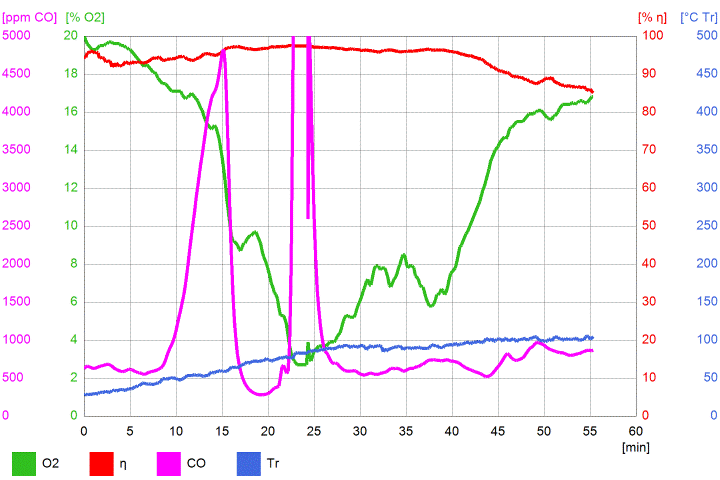 In general, I am trying to find out what are essential details and what are not. To sum up: only a severely restricted core exit (105% of port's csa) and nothing at the top box ceiling or on the shelf doesn't do the job. A combination of stumbler on the shelf or ceiling and a large core exit doesn't work ideally either. The linear distance between the port and the stumbler is essential, but not enough on its own. (Also the same in the DSR2 configuration.) Conclusion so far: there should be a shelf as well as two different restrictions in the upper box, the larger one downstream. It will always be a temperamental combustion core, precise details are essential, no doubt about. Exactly what you found out, Trevor. As a side note: I've got the impression the afterburner area could be a bit wider. As it is now, the width of the area is twice as wide as the height. Both vortexes visibly aren't circular, a bit higher than wide. More like a slight oval. It did stay this way irrespective of the velocity and intensity of the spinning flames. |
|
|
|
Post by peterberg on Oct 27, 2020 7:41:38 GMT -8
Today another test run, configuration exactly the same as two diagrams ago. Loaded with dry round willow as before but I allowed some space between the fuel and the rear wall this time around. Starting up was slow and consequently the startup CO level went up before the double vortex kicked in at 20 minutes into the burn. Once that happened it behaved confirm wishes, even the lowest O² level of 4.4% didn't appear to have a noticable impact. 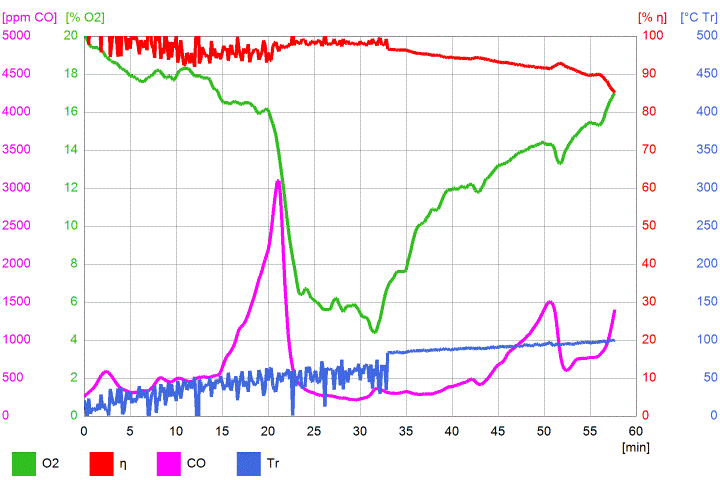 The mechanics are doing what we want it to do, maybe it could improve a bit by adding some form of secondary air. A slit in the sides of the port looks like a possibility although at the moment I don't have a clue how to get enough heated air at that particular spot. The definition I formulated this morning is not entirely correct. To my mind, it should be something like this: This core seems to work best using three consecutive restrictions, seen in upstream direction the tightest first and each following one a bit wider. One (the tightest) between the firebox and afterburner, the other two above the shelf in the top box. I have to check whether it makes a difference if the second restriction is hanging down from the ceiling or resting on top of the shelf in the top box. |
|
|
|
Post by peterberg on Oct 27, 2020 12:38:11 GMT -8
Although this morning's run was not bad, I wanted to do a testrun while the core's on working temperature. So I did, this evening, same configuration, same load, same fuel species, wind velocity, you name it. This test turned out to be a very pleasing one, although there's a small CO bump in the beginning, the end level was even lower. Not that the lowest CO level was extremely low, just that the overall level happened to be quite nice. 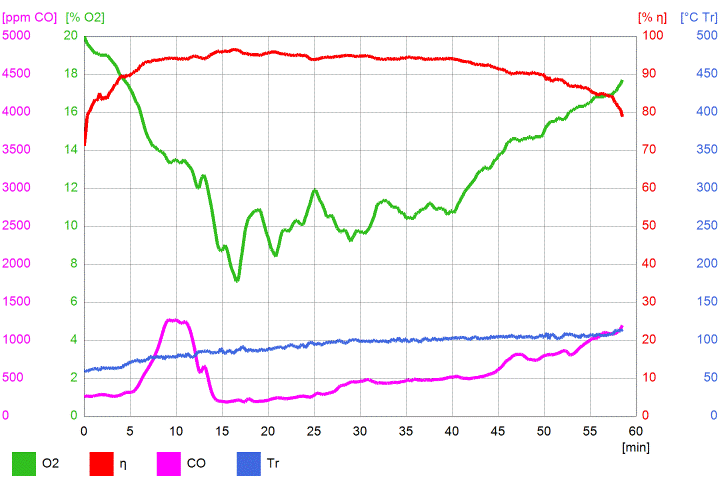 Averages of this burn: 12.9% O², 91.9% eff., 552 ppm CO, 92.8 ºC (199 ºF). End-of-test according to the coming EU norm. Next test would be one with beech and oak as fuel. I have a very limited amount of hardwood, good enough for two runs probably. |
|
|
|
Post by Vortex on Oct 27, 2020 15:57:46 GMT -8
As a side note: I've got the impression the afterburner area could be a bit wider. As it is now, the width of the area is twice as wide as the height. Both vortexes visibly aren't circular, a bit higher than wide. More like a slight oval. It did stay this way irrespective of the velocity and intensity of the spinning flames. That was intentional so that the bottom edge of the vortex would be forced into the jet of flame coming out of the port. I thought it would induce better mixing of the gases that way. Also it was exactly the fire brick size we get here which made things a lot easier  The definition I formulated this morning is not entirely correct. To my mind, it should be something like this: This core seems to work best using three consecutive restrictions, seen in upstream direction the tightest first and each following one a bit wider. One (the tightest) between the firebox and afterburner, the other two above the shelf in the top box. I have to check whether it makes a difference if the second restriction is hanging down from the ceiling or resting on top of the shelf in the top box. That's my experience as well. Haven't tried the stumbler on the ceiling on mine, as I wanted to push the hot gases against the underside of the hotplate, not away from it. |
|
|
|
Post by Vortex on Oct 28, 2020 3:05:54 GMT -8
I forgot to ask, what is your firebox port size? I cant find it anywhere in the thread.
|
|
|
|
Post by martyn on Oct 28, 2020 6:30:24 GMT -8
Assuming Peters version has ceramic board (?) where Trevor’s has a steel plate for the roof .... do you see this difference having any significant effect?
|
|
|
|
Post by peterberg on Oct 28, 2020 7:50:29 GMT -8
I forgot to ask, what is your firebox port size? I can find it anywhere in the thread. It's 50% csa of 120 mm system size just like yours, and mine in DSR1. |
|